As horseback riders, we know that riding works some very unique muscles and can create some stiffness and soreness in locations we never knew existed!
What?!?!? I have a muscle there?!?!?
This post will cover a few of my go-to static and dynamic stretches on horseback that I often incorporate into both adaptive (students with physical, cognitive, or emotional disabilities) and able bodied (typical students without impairments) lessons.
What’s the difference between static and dynamic stretches?
This article by Michael Curits, PT explains them by defining them as:
Static– a stretch to lengthen a stiff muscle by taking it passively to it’s end range for a prolonged period of time.
Dynamic– a stretch used to prime a muscle for activity or sport by using momentum to take it throughout it’s full range of motion.
Static– a stretch to lengthen a stiff muscle by taking it passively to it’s end range for a prolonged period of time.
Dynamic– a stretch used to prime a muscle for activity or sport by using momentum to take it throughout it’s full range of motion.
Timing of the stretches:
I incorporate dynamic stretches (to prime the muscles) before riding, during the warm up, and at the end of a ride depending on the needs of a student.
I usually reserve static stretches for times where the rider and horse are already physically warmed up and blood is flowing (ex: after a few laps, both directions, of walk and trot)
Often times I will give some ‘homework’ for riders to do at home that is a combination of dynamic and static stretches. The ‘homework’ assigned sometimes varies from student to student depending on what we are working on and/or where they might be stuck. If you are working with an individual that has an old injury, has a physical disability, etc. please, please seek out resources and advice as needed. Remember that this is general advice and information you are giving and it should not be presented in a way that you are saying that you are a therapist, physical trainer, etc.
What prompted this post on stretching?
I have been recently teaching as a guest instructor for a mounted police school where I have been incorporating more static and dynamic stretches than I normally do in my regular lessons (I push my regular crew of students to where they have tired muscles…but usually not as much as I push the officers during the school). This is an intense, fast moving, and physically demanding training where we regularly push the officer’s bodies as far as we can (just far enough so they can still practice correct and maintain good position) they can gain as much time in the saddle (most of them come in with little to no riding experience so this six week long course gets them geared up and ready to test out for the mounted unit). Because the officers are spending so much time in the saddle at all three gaits they are naturally going to be a little stiff and sore as they get used to using their bodies in a ‘riding’ way. They have quickly learned that riding is more than just letting the horse pack you around the arena.
The officers that are on the mounted unit spend hours in the saddle at the time without dismounting. This leads to stiff joints, sore seats, etc. if they do not move and stretch out occasionally.
One of the first days I worked with the students in the school, we went over ground and mounted stretches and warm ups that they could do during the mounted school as well as when they are on duty riding/patrolling and feel some stiffness coming on. I wanted them to get into a routine of regularly incorporating the stretches so they would hopefully continue to incorporate them after the mounted school was complete. New ground and mounted stretches outside my usual go-to positions are incorporated as the school progresses depending on what I see with the students.
Even though my regular set of students do not get exerted as much as the officers do during the mounted school or while out on the streets, it is still good practice to consistently incorporate warm ups, stretches, and cool downs that are suitable to our students. After all, riding can be a very physically demanding recreational activity or sport! Yes…even at the walk!
An important note about balance and our equine coworkers during stretching and warm-up activities
We should not forget about the well being of the horse just because we need a good stretch at that time.
Balance and being a good partner to the horse is something that I reinforced every single stretch with every single rider (adaptive and able bodied)…and I encourage you to do the same.
When we do stretches on the ground or on other exercise equipment and we become off balance, often times the only thing that is affected is us, the human. We may stumble, fall out of a position, etc. but our actions don’t directly impact another living being.
When we stretch on horseback we not only affect us, but also our horses. It is important to teach riders to be aware of how to stay as balanced as possible while doing mounted stretches so we do not cause discomfort to the horse just for the sake of us getting a good stretch.
Stretching can be a wonderful way to build body awareness, stability on the horse, and increase confidence in the saddle…..if you prioritize the importance of staying balanced AND getting a good stretch.
Here is a list of my go-to stretches.
Note: there are certainly others that I uses but these have been the most recent.
Mounted quad stretch (static)
Where you will probably feel it:
- Quads
- Shin and ankle – if the rider grabs more at the top of the foot instead of on the bottom of the shin they can often feel stretching in these locations.
- Hips- depending on the flexibility of the rider, build of the horse, etc. the rider may feel a stretch in the hip area
How do you do it?

- Rider drop’s their stirrups (if it is a new rider you can have them leave one foot in the stirrup)
- Remind the rider to stay centered over the horse and not lean to the side of the leg that is not being stretched.
- Slowly bend the knee and bring the lower leg up towards the seat taking care to stay centered and not bump the horse’s sides.
- Grab the bottom of the shin or the top of the foot with the hand on the same side as the leg that is being stretched.
- Breath for several breaths while looking out over the horse’s ears then slowly let the leg go and stretch the other side.
Want more stretches that target the quads…click on the links for articles. Some of the stretches may be able to be adapted to mounted stretches and some may need to be done on the ground before or after riding. (This note about being able to adapt applies to the links in the stretches below as well.)
Mounted glute stretch (static or dynamic)
Where you will probably feel it:

- Glutes
- Hips- again depends on the flexibility of the rider, build of the horse, etc.
- Hamstrings- especially if the rider focuses on keeping the upper body tall
- Lower back- you can get more stretch in the lower back the more you draw the leg up into the chest and if you gently tilt (slightly) forward
How do you do it?
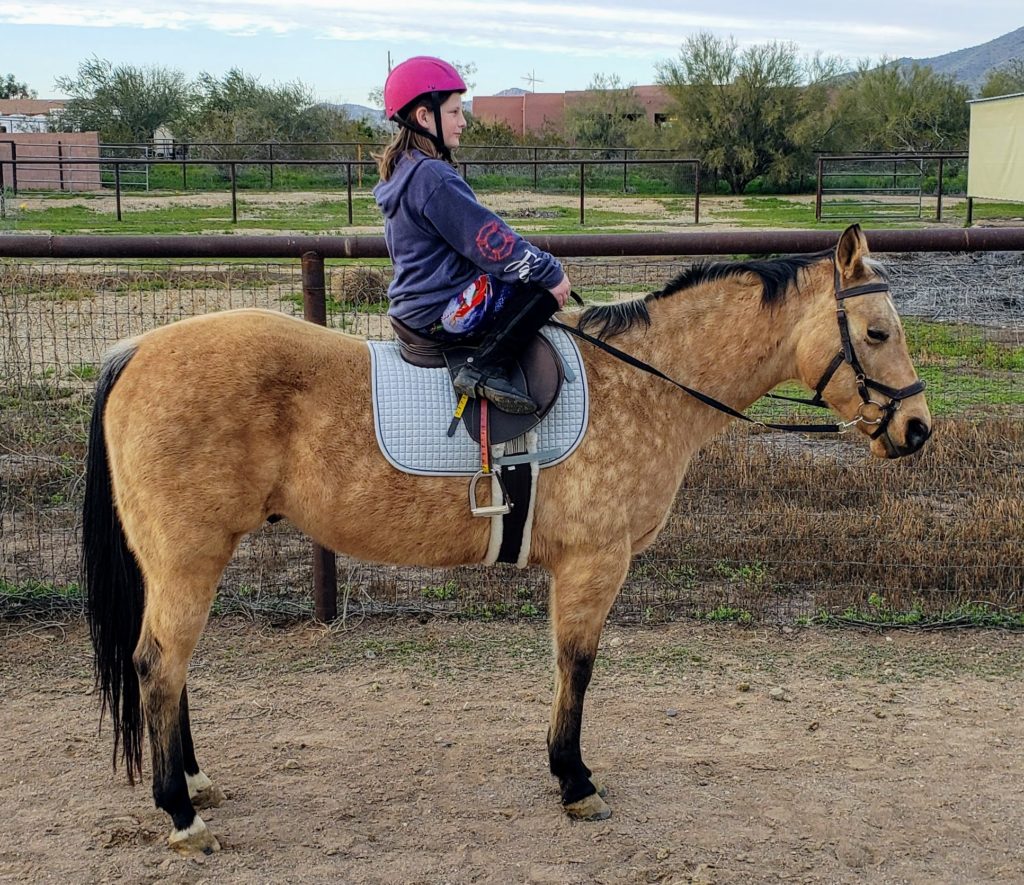
Notice rider is not leaning too far forward or back.
- Rider drop’s their stirrups (if it is a new rider you can have them leave one foot in the stirrup)
- Remind the rider to stay centered over the horse and not lean to the side of the leg that is not being stretched. The rider should also try to remain up right as much as possible and not bend forward.
- Slowly bend the knee and bring it up at an towards the belly button (think about sliding it along the angle of the horse’s shoulder as it goes to the withers).
- Grab the front of the knee or the shin with one or both hands and slowly stretch the leg towards your core.
- You can add in some ankle flexion (toe up, toe down) as well.
- Breath for several breaths then slowly let the leg go and stretch the other side.
Want more stretches that target the glutes and hamstrings…click on the links for articles.
Lower back stretch… AKA the ‘frog’. (static)
Where you might feel it:
- Lower back and lats
- Hamstrings and glutes
- Hips
- Triceps, biceps, shoulders
How to do you do it?
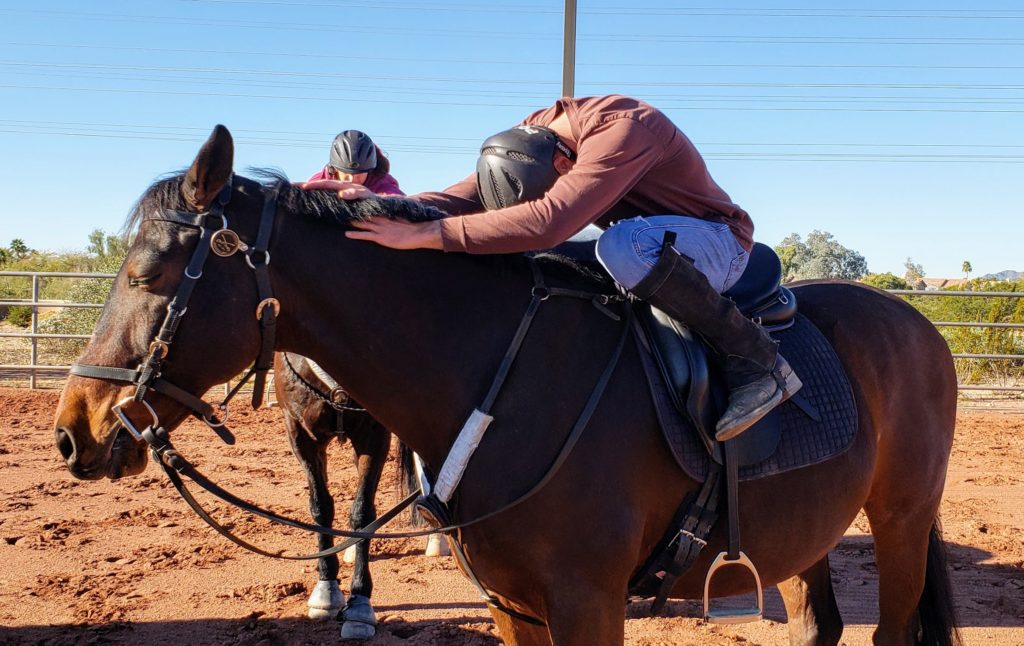
- Rider drops both stirrups
- Remind the rider to stay centered over the horse.
- While staying upright with the upper body, slowly bend both knees and bring them up at an angle towards the withers.
- Once the knees are up by the withers, have the rider take a deep breath and stretch their arms forward to the ears as they slowly lean forward by bringing their chest down towards the neck of the horse.
- Take several breaths in this position then slowly sit up bringing the upper body upright first then extending the legs down
Want more stretches that target the lats and lower back…click on the links for articles.
Core Twist (static)
Where you might feel it:
- Lower and mid back
- Abdominals
- Hips
How to do the stretch:
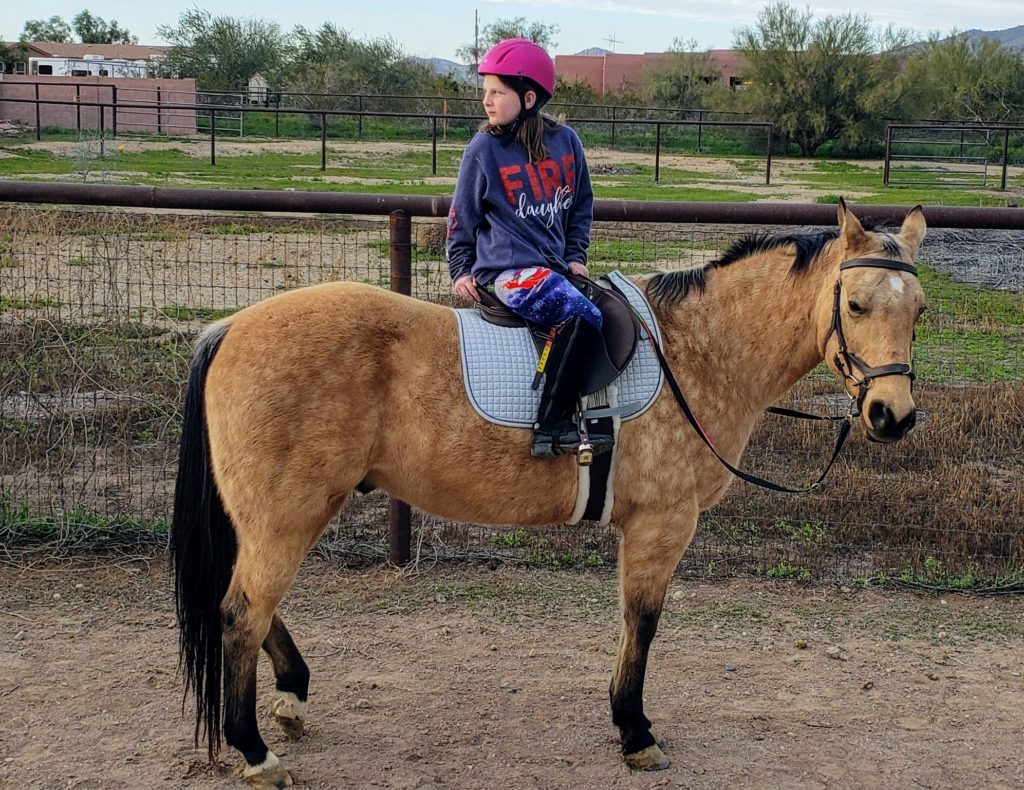
Cupid rested his hind foot right as we took the photo.
- The rider can leave feet in or out of stirrups for this stretch. Lower leg needs to maintain proper location during the entire stretch
- Have the rider grab the pommel or horn of the saddle with one hand and the cantle with the other.
- Breathe out as the rider turns their body from facing forwards to facing as far sideways as possible.
- Make sure the lower leg does not move from the the typical position (often riders will let their lower leg push forward or bend back)
- Take a few deep breaths at the point of maximum stretch then slowly come back to center.
- Repeat on the opposite side.
Want more stretches that target the core…click on the link for articles.
Fingertip Twist (Dynamic)
Note: I don’t know the formal name for this stretch but this was taught to me by my PT/Chiropractic office. I do this stretch on a regular basis as I personally hold a lot of tension in my shoulder blade area. This stretch works best if you are seated.
Where you might feel it:
- Shoulder and shoulder blade area
- Lower back
How to do the stretch:
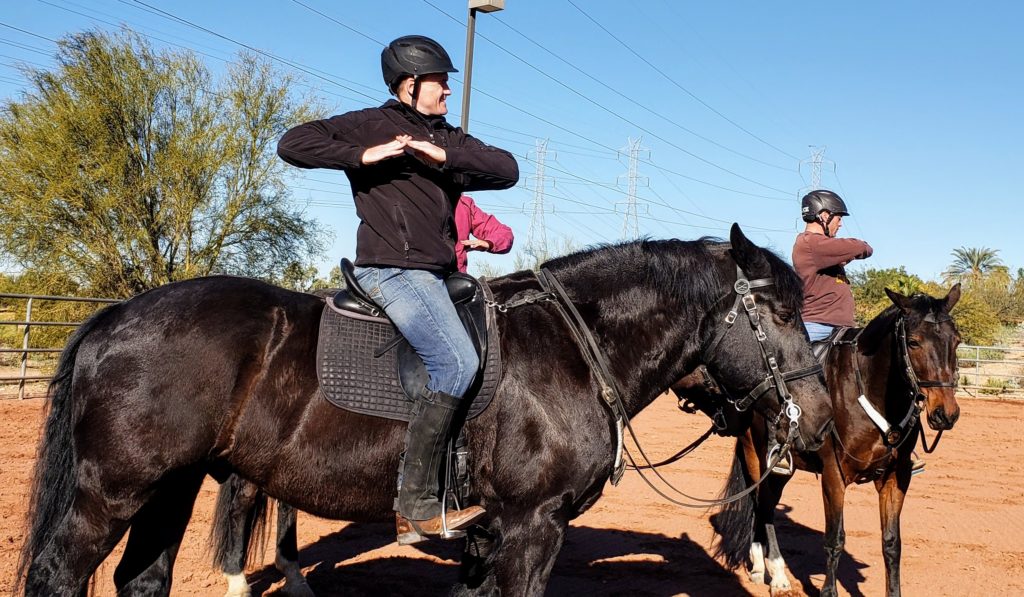
- While sitting centered, stretch arms out to the side (airplane) then bend at the elbows and touch your fingertips together under your chin.
- Keep arms in this position and slowly twist from side to side taking care to stay centered and not lean.
- Do deep breaths during the stretch
Want more stretches that target the shoulders…click on the link for articles.
Standing Calf Stretch (static)
Where you might feel it:
- Calves
- Ankles
- Inner thigh and hamstring- depending on flexibility of rider and build of horse.
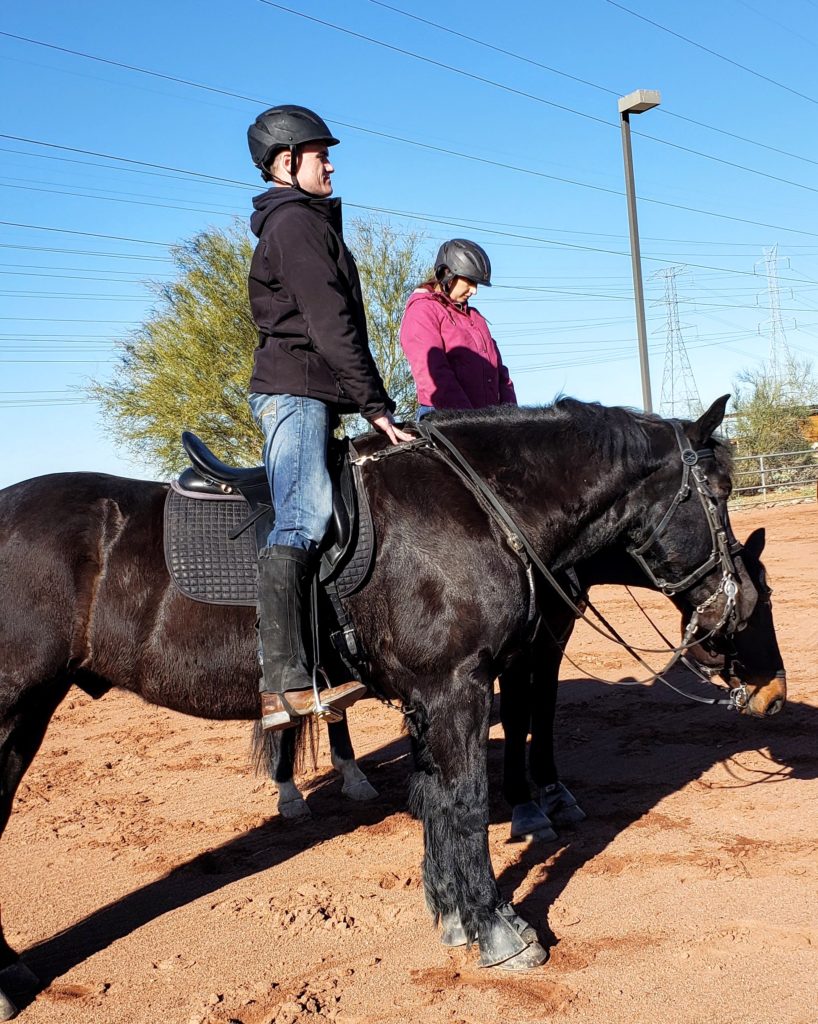
How do you do it:
- Explain that even though the rider is lifting their seat out of the saddle this position is not the same as a 2-point and is for stretching purposes only.
- Have the rider slowly rise out of the saddle and into a stand while focusing on staying balanced.
- Allow the ankles and calves to stretch down (in a more exaggerated way than when in 2-point) and not allow the leg to swing forward or back.
- Gently sit back in the saddle by bending the knees then the hips.
Note: If this is a beginner rider that is still working on solidifying their 2-point and/or half-seat position I will usually have them demonstrate one or both of those positions. Why? I want the rider to end with the feeling the 2-point or half seat to make sure they are not confused.
Want more stretches that target the calves …click on the link for articles.
One arm “up” stretch (static)
Where you might feel it:
- Shoulders
- Forearm (if you flex the hand back and forth)
- Sides (obliques)
How you do the stretch:
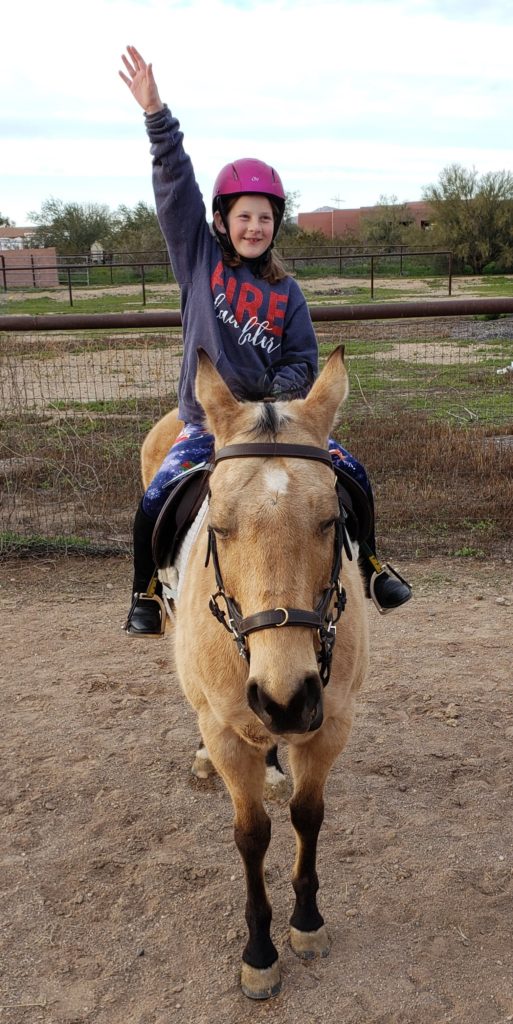
- Feet can be in or out of the stirrups. Take one arm and stretch it straight up to the sky as you take a deep breath.
- To add more stretch to the side (obliques) the rider can slowly bend away from the side of the stretched up arm. If they choose to do this they need to take care to stay as centered as possible and not lean to far to one side.
- Keep taking deep breaths and bring the stretched-out arm down and repeat on the other side.
Want more stretches that target the arms…click on the link for articles.
Ending Notes and Tips:
- Remember to not only focus on your rider and how they are feeling but also the horse.
- School your horse with a mock rider (you, a volunteer, another instructor) doing the stretches before you have a student try.
- If you ask your student to set their reins down during certain stretches make sure they know how to gather them back up if the horse starts moving and make sure your horse has been schooled to stand with loose reins.
- If reins are set down on the horse’s neck keep an eye on their position. Are they centered? Are they set back by the withers or slipping down the neck?
- Train your volunteers how to support the students appropriately during the stretches (if your student has support).
- Check in with your student to make sure the stretches are not causing excess discomfort.
- Unless you hold the correct training/credentials…remember that you are not providing ‘therapy’ just because you incorporate stretches into your lesson! You are just being a very thorough instructor.
- If something does not feel right or look right…stop! Seek out advice from a PT, OT, athletic trainer, etc. if needed if you are not sure what activities are suitable for your student.
- The activities in this post may not be suitable for every rider or every horse. It is your responsibility as the instructor to make an educated and safe decision on what activities you incorporate into your lesson.

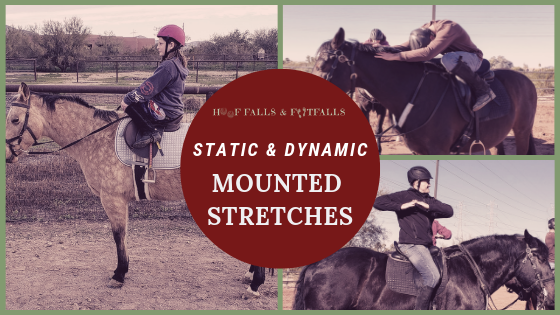
Very informative got some good ideas
Glad you enjoyed the article!
very good article
Thanks for reading! Glad you enjoyed the article